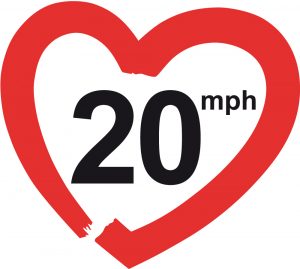
On Wednesday 23rd February a motion will be put to Eastbourne Borough’s full council asking them to support the “20’s plenty for Eastbourne” campaign. The full motion is included below, but to summarise, the 20’s Plenty campaign asks for 20mph to be the default speed in areas where people live, shop, eat and go to school. A 20mph speed limit is an important step towards making our streets cleaner and safer for pedestrians and cyclists, actually for everyone.
Did you know that the United Nations General Council declared 20mph (or 30kph) as maximum speed limits for areas where people mix with motor vehicles, unless strong evidence exists that higher speeds are safe in those areas. In February 2020 the UK government signed up to the Stockholm Declaration, which agreed to introduce a general speed limit of 30kph/20 mph in all living areas in 140 countries. Cities and towns across the world have already adopted these safer speeds which aim to half traffic deaths by 2030.
Meanwhile in the UK:
- Wales is implementing a 20mph national default for residential roads
- Scotland is about to roll out 20mph zones across the country after evidence indicated it has made neighbourhoods safer and greener in Edinburgh and elsewhere.
- Westminster has left it to English local councils to make their own decisions.
- Most of the UK’s larger cities have already adopted 20 mph for their residential streets
- Oxfordshire county council have approved a countywide 20mph speed restriction in areas that have traditionally mainly been 30 mph limits
- Many other town and county councils are doing the same
- Government and other surveys consistently find 70% support for 20mph in residential streets. This support rises even higher after 20mph limits are introduced.
In Eastbourne and Willingdon, speed limits are set by East Sussex Council and so far ESCC are proving tough to convince of the need to follow the UN’s commitments, or even the UK government’s commitment. Our job is to persuade them that they need to start listening. More details on what you can do to help below, but first a few more details about the motion and why it is so important.
The motion
The motion being put to Eastbourne Borough Council is to ask for their support for the 20’s Plenty campaign. Eastbourne Borough Council and Wealden District Council can’t set the speed limits themselves, but they can lobby East Sussex. Many of your local councillors are also county councillors, so they really can make a difference. Step one is to get Eastbourne Council’s support at their February all members meeting. There will be another motion put to East Sussex County Council in March. The motion being put to Eastbourne on 23rd February is that:
Eastbourne Borough Council:
- Supports the “20’s Plenty for Eastbourne” campaign;
- Calls on East Sussex County Council to implement 20mph in Eastbourne; and
- Will lobby East Sussex County Council to request making 20mph the default speed limit on streets throughout Eastbourne in places where people live, work, shop, play or learn, leaving 30mph as the exception on those roads, where full consideration of the needs of vulnerable road users allows a higher limit.
What does changing the default speed mean?
In East Sussex the default speed limit on our streets is 30mph. If a community believes that driving at 30mph is not safe on their streets, they must provide evidence before East Sussex will consider changing the speed limit. Evidence means road deaths, or a number of serious accidents.
If instead the default speed limit was 20mph and a community wanted the higher 30mph limit, the responsibility changes to demonstrating that 30mph is a safe speed for all road users. For example, by having pavements and a safe space for cyclists.
Government guidance on setting local speed limits (published January 2013) is that
“Traffic authorities are asked to:
- keep their speed limits under review with changing circumstances
- consider the introduction of more 20 mph limits and zones, over time, in urban areas and built-up village streets that are primarily residential, to ensure greater safety for pedestrians and cyclists, using the criteria in Section 6″
Circumstances have changed significantly since 2013. For example, a 20mph speed limit in streets where people live, work, eat, play and learn is an essential complement to the recent changes to the Highway Code.
Why do we need slower speed limits?
The facts speak for themselves here:

Slower speeds save lives.
Being hit at 20mph is like falling from a first floor window. At 30mph it’s like falling from a third floor window.
The UK’s Department for Transport estimates that a speed reduction of 1mph in built-up areas reduces casualties by 6%. 20mph schemes typically lead to up to 20% fewer casualties.

Slower speeds give drivers more warning
The recent changes to the highway code require drivers to give way to more vulnerable road users at crossings.
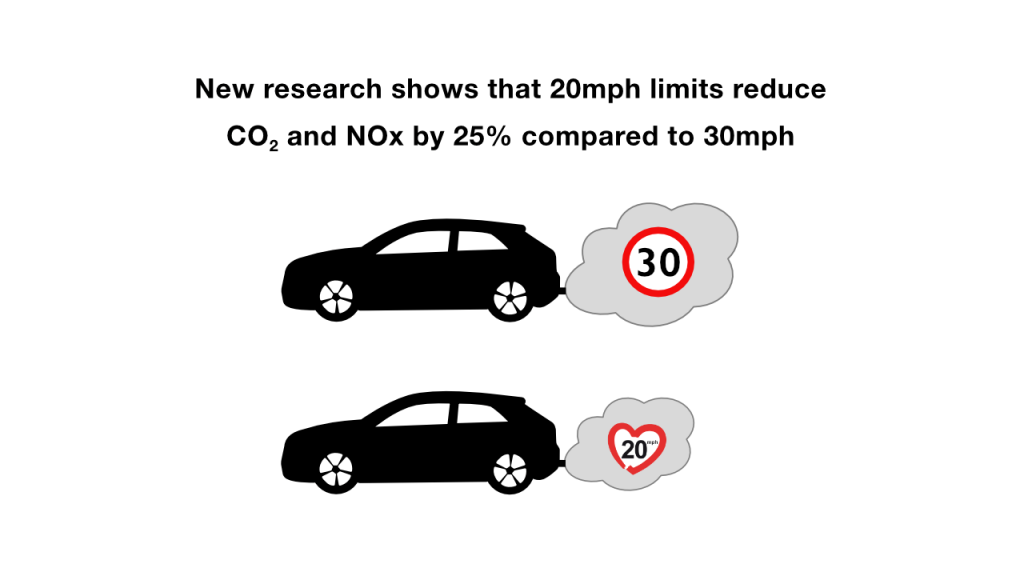
Slower speeds are better for the environment
20mph reduces CO2 emissions by 26% and NOx by 28% compared with 30mph and is 50% quieter.
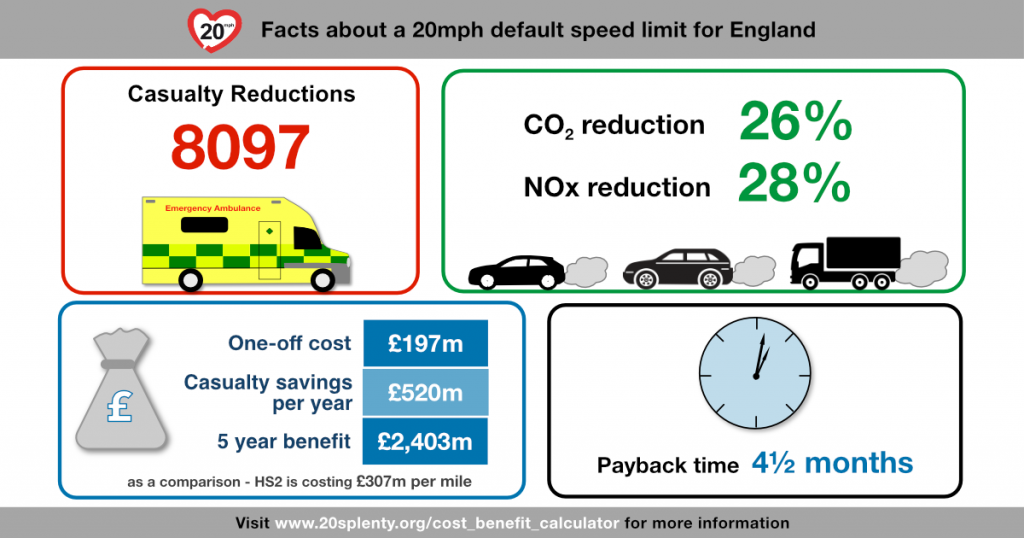
Reducing speeds saves money as well as lives
Estimates show that reducing seed limits will lead to 8,097 les casualties each year across the UK, saving £520m. Can our cash strapped government and county councils afford to ignore this advice?
East Sussex County Councillors have previously argued that it is only necessary to reduce speeds in the immediate vicinity of schools. This contradicts guidance from the UN and countless environmental and safety organisations.
- Consistent speed limits across towns are more cost effective. You only need to change signage. There is no need to alter road structure or add physical traffic calming such as speed bumps.
- Consistent speeds are easier for drivers and pedestrians to understand.
- Consistent slower speeds mean less accelerating and braking, hence less pollution and less fuel wasted.
- What’s the point of making the last 50 yards of a journey to school safer if the rest of the journey is still a terrifying ordeal? If children can walk or cycle safely to school, then parents don’t need to drive them to school.
- Lower speeds are essential to bring about a modal shift in transport and encourage more active living, more walking, more cycling and less reliance on cars.
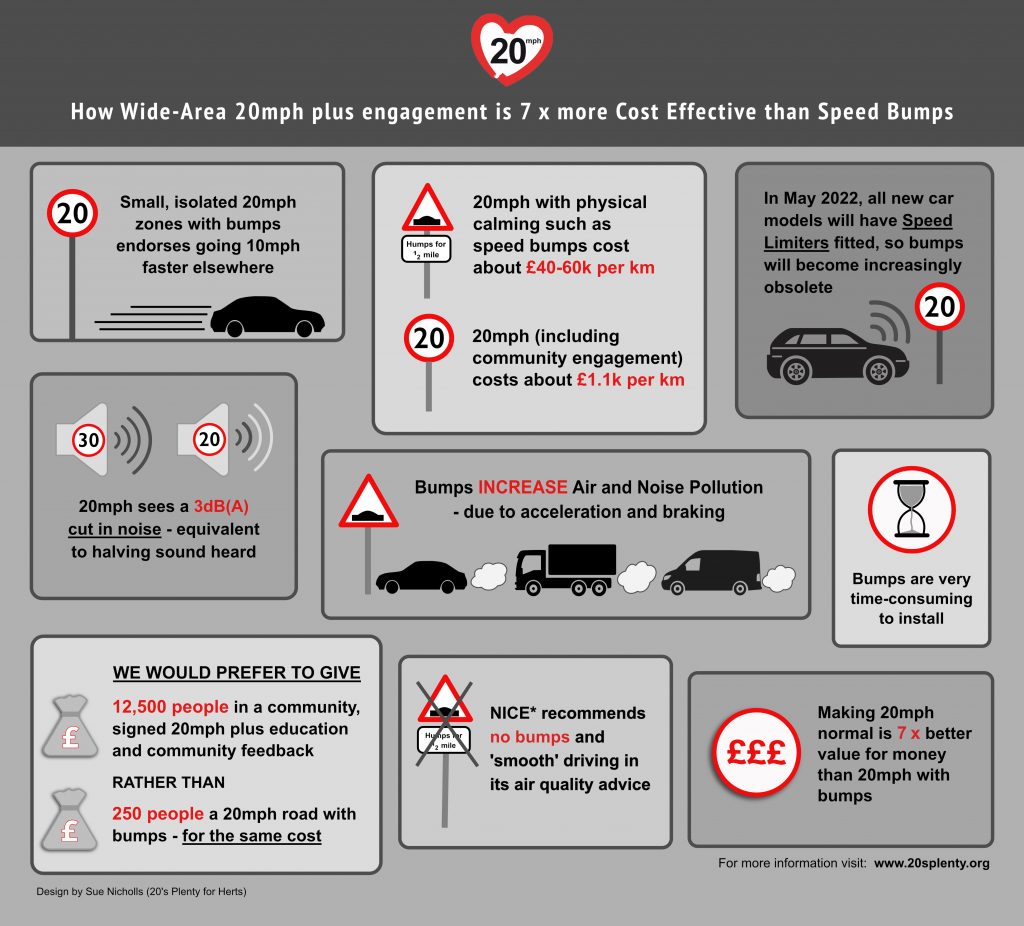
Consistent 20mph speed limits are inexpensive
much cheaper and more effective than isolated speed bumps.
What can you do?
Please help us to persuade our councillors to make the right decision for the greater good of residents and local businesses. You can do this in any, or all, of the following ways:
You can write to your MP and to your local councillors
An easy yet effective way to get a message to your MP and councillors is to write to them by email, or post. Feel free to write your own letter, but there are some ideas for content below.
See also contact details of local councillors and our MP. (this link will open in a new tab)
You can greet councillors as they arrive to vote on the motion
Eastbourne Borough Councillors will be voting on a motion to support 20’s Plenty for Eastbourne at the full council meeting at 6pm on February 23rd 2022. Come along ready for 5.30pm to greet councillors as they arrive and let them know why they should vote for the motion. Bring family, friends, pets, rattles, posters – anything you have to get your message heard, or seen. UPDATE: The full council meeting has been moved to the Welcome Building to accommodate more people. The Welcome Building is next to the Congress Theatre:
Welcome Building: corner of Carlisle Road/Compton Street, Eastbourne, BN21 4BP
You can use social media to spread the word – #20sPlentyforEastbourne
WhatsApp local parents, teachers and tell them about 20’s plenty for Eastbourne.
Copy or Share any of the graphics from this page and include them in a Twitter, Instagram or Facebook post. Use the hashtag #20sPlentyforEastbourne
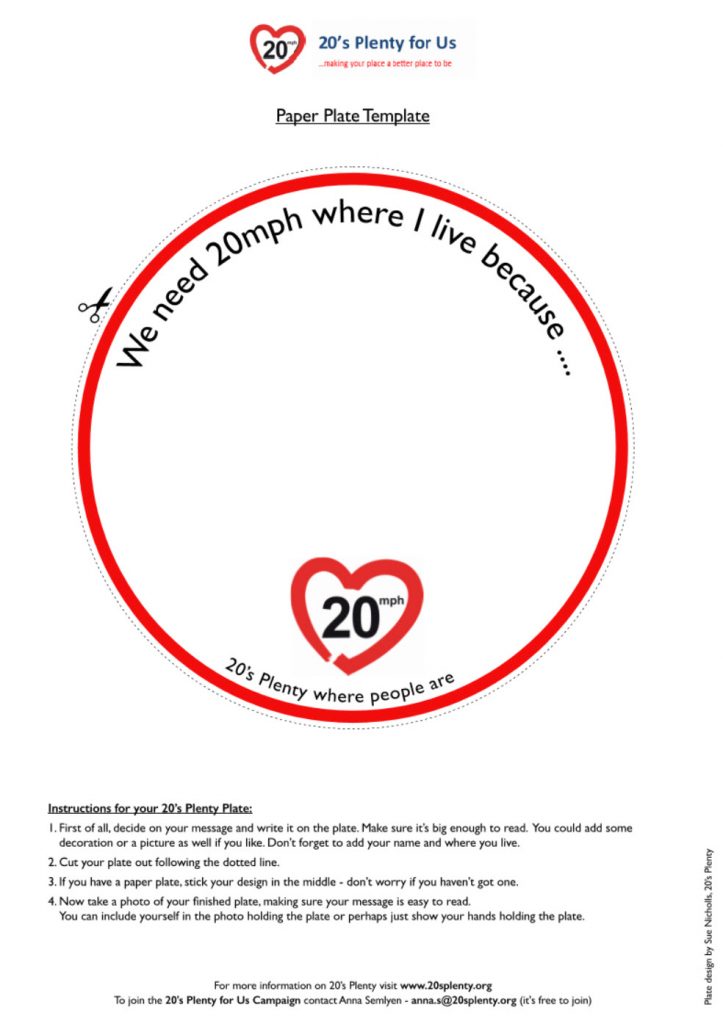
Download and print out this paper plate.
Write or draw your reason for wanting 20mph where you live. Take a picture of the ‘plate’ and share by social media
Writing to your councillors and your MP
Personal letters are more effective, so do add your own reasons, but some things you can include:
Dear (WARD/division NAME) Councillors
I am writing to ask you to help make (WARD/divison NAME) a safe and more environmentally friendly place and to support the 20’s Plenty for Eastbourne Campaign with your vote.
On 23rd February a motion will be put to the full Eastbourne council asking that
Eastbourne Borough Council:
- Supports the “20’s Plenty for Eastbourne” campaign;
- Calls on East Sussex County Council to implement 20mph in Eastbourne; and
- Will lobby East Sussex County Council to request making 20mph the default speed limit on streets throughout Eastbourne in places where people live, work, shop, play or learn, leaving 30mph as the exception on those roads, where full consideration of the needs of vulnerable road users allows a higher limit.
This motion is necessary to enable us to lobby ESCC to deliver these changes on our behalf. The achievement of a 20mph zone will have lasting impact on the health and wellbeing of (WARD/division NAME) residents and is highly likely to improve the prosperity of small local businesses and traders. A number of councils have successfully implemented similar schemes in cost-effective ways, using only signs and without the need to remodel streets, or conduct expensive traffic flow analysis.
Please act for the greater good of the residents of (WARD NAME) and vote in support of 20’s Plenty for Eastbourne on 23rd February at Full Council.
Yours sincerely
(Name)
(Address) – you must include you address or your letter/email will be ignored.
Add the following to the end of your letter:
Justification and background to the motion
- Accepted as normal by local authorities where 25m people in the UK live, including the whole of Wales and (soon) Scotland. 20mph is global best practice where people mix with motor traffic.
- Popular: Government and other surveys consistently find 70% support in residential streets which rises after 20mph limits are introduced.
- Affordable and cost effective, with multiple societal, environmental, economic, and climate benefits.
- Prioritise quality of life: 20mph helps to create places where human activity, including walking, cycling and social interaction, takes precedence over traffic.
- Safer: The UK’s Department for Transport estimates that a speed reduction of 1mph in built-up areas reduces casualties by 6%. 20mph schemes typically lead to up to 20% fewer casualties.
- Better for the environment: 20mph reduces CO2 emissions by 26% and NOx by 28% compared with 30mph and is 50% quieter.
- Enforceable, like any speed limit.
- Little impact on journey times: The ‘stop-start’ nature of traffic in built up areas is a much more significant factor. Roads can stay at 30mph where the needs of vulnerable road users are met. Bus journeys and timetables times are generally unaffected.
- Speed reductions occur, even without regular Police enforcement, to the benefit of all road users. Note: all new car models will have in-car speed limiters from 2022.
- Few signs needed: 1 or 2 signs on entry and some repeaters to remind drivers and no need for physical calming.
- Sustainable: Ties in closely with other policies to address climate change, improve air quality and enable more people to walk and cycle – especially for short journeys.
See also contact details of local councillors and our MP. (this link will open in a new tab)

I can’t claim the credit for getting the motion before council. Tondra Thom and others have done the hard work there. But, I am 100% behind this motion. It is essential to reduce accidents and improve our environment in many more ways than one!
Thank you for bringing this motion to Eastbourne Borough Council. Eastbourne will be a much better place to live with 20 miles per hour in all residential areas. Imagine it. Quieter. Safer. Cleaner air. More people walking, cycling, smiling. I’ll be there on 23rd February with my Unite the Union whistle!